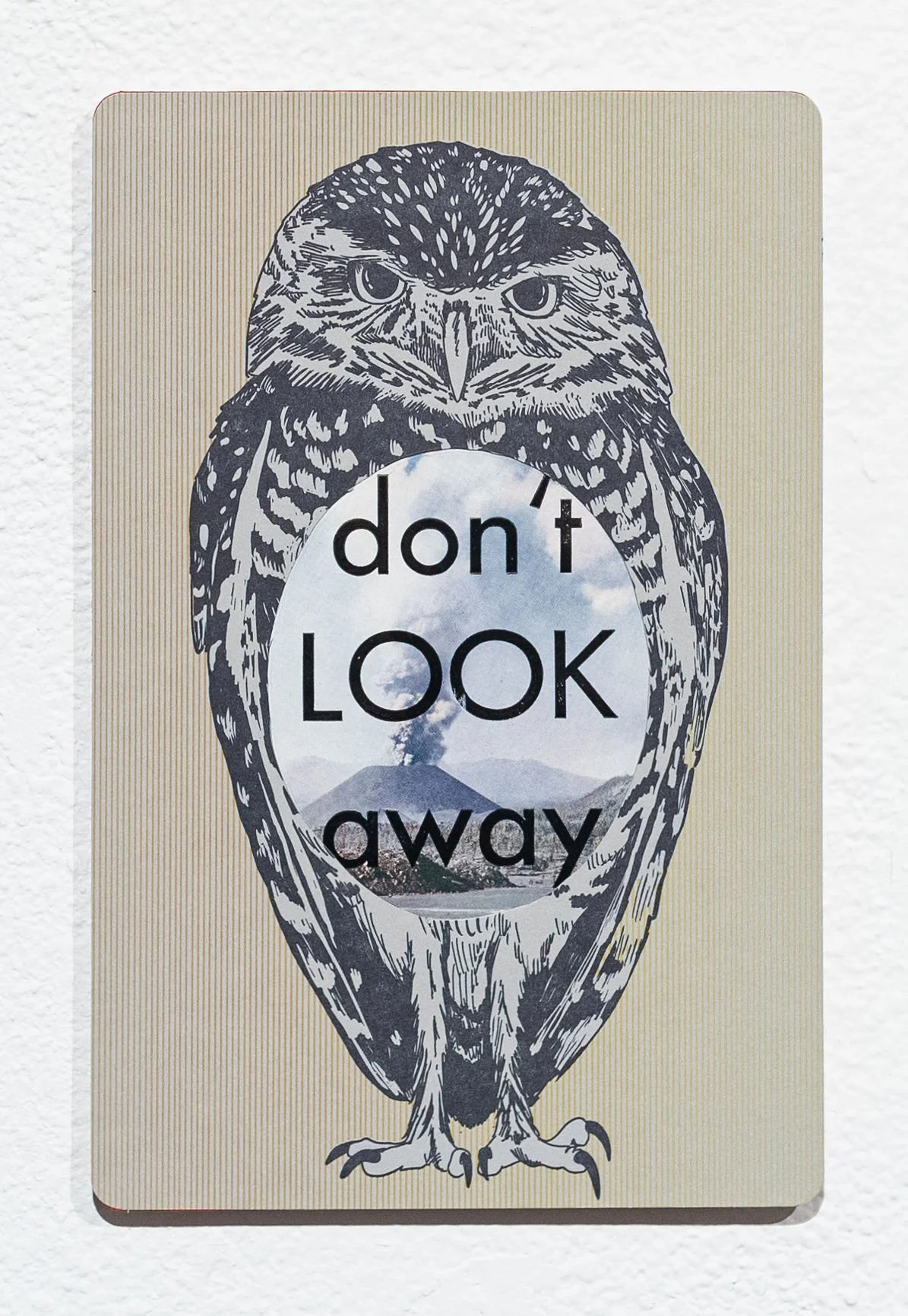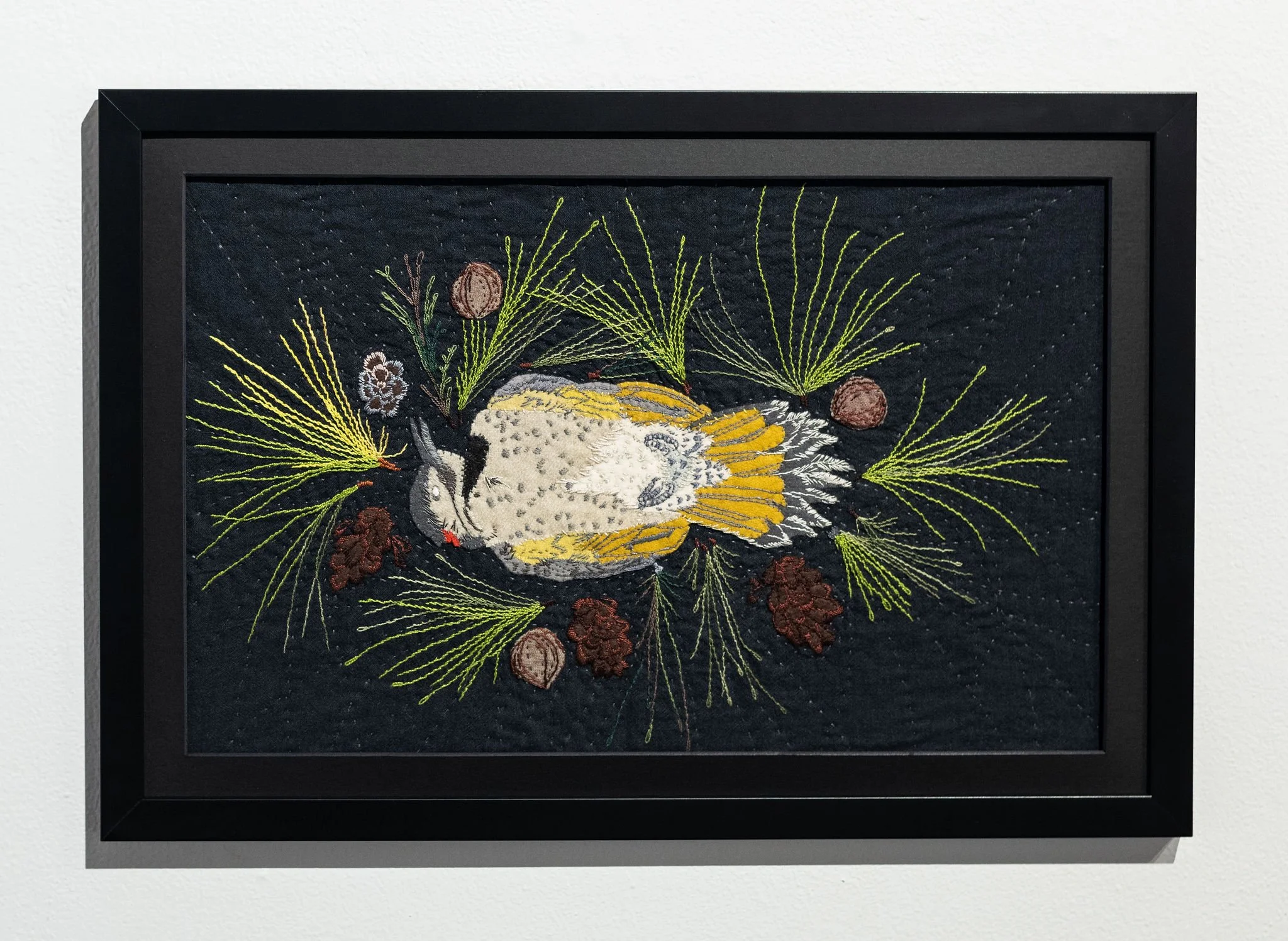Kathryn Hunter
Kathryn Hunter grew up in North Alabama and then spent 10 years in the Montana mountains before moving to South Louisiana in 2000. She has a BFA (1999 Montana State University) and an MFA (2003 Louisiana State University), both in printmaking. In her fine art practice, she works in mixed media, from embroidery to letterpress and laser cut steel to paper cutting, with which she exhibits in galleries across the US. Her work incorporates animals as characters in the folktale tradition commenting on false prophets, the damage of white supremacy, America's freedom, and the erosion of our environment. Her work is represented by LeMieux Galleries in New Orleans. She is an artist member of Baton Rouge Gallery and the art collective, Luminous Lookout. Her work is part of the permanent collections of the LSU Museum of Art, Hilliard Art Museum, and Sam D Hamilton Noxubee Wildlife Refuge among others. Since 2003, she has operated Blackbird Letterpress, a small letterpress printshop where she and her team design, print, and assemble handmade notebooks, quirky animal-shaped greeting cards, and products featuring Inspiring Women in history. She has designed and illustrated 3 gift books for Clarkson Potter (Penguin Random House) and is currently working on two other books for the same imprint. In addition, her design work has been commissioned by the Metropolitan Museum of Art,- in New York City, the Norton Simon Museum- in Los Angeles, and the Historic New Orleans Collection among others. Her work is featured in Keeper of the Tale Trilogy novels by Ronlyn Domingue (Atria Books 2014). In 2020, she organized and participated in the print portfolio titled: Inspiring Women: 25 Women Who Were True Catalysts of Change. Copies of the portfolio are now part of the permanent collections of The Library of Congress, the National Museum of Women in the Arts, and Smith College Special Collections, among other institutions.
Artist Member since 2008
Bachelor of Fine Arts (Printmaking), Montana State University, Bozeman
Masters of Fine Arts (Printmaking), Louisiana State University
current works
wool appliqué, embroidery, hand sewing, wool, cotton and fluorescent threads
22" x 18"
Wool appliqué, embroidery, hand sewing & quilting, machine piecing, cotton, fluorescent, glow-in-the-dark and cotton threads.
Indelible Tales presents the cosmos of permanent marks made by the highest court in the land, the Supreme Court. Marks made intentionally, thoughtfully, and mindfully creating an everlasting legacy that continues to shape our cultural landscape today.
Dred Scott v. Sanford, 1857 - stated that enslaved people were not recognized as US citizens, therefore could not expect protection by the federal government.
Elk v Wilkins, 1884 - ruled that Native Americans were not citizens by birth under the 14th Amendment and therefore did not have the right to vote.
Plessy v. Ferguson, 1896 - Upholding a Louisiana state law, this ruling stated that the constitutionality of racial segregation laws did not violate the equal protection clause in the 14th Amendment and were therefore legal with separate but equal accommodations for the "white and colored races".
US v Bhagat Singh Thind, 1923 - decided that Thind, an Indian immigrant who would have been identified as Aryan or Caucasian, was not eligible to be a US citizen because he was not "white" in the eyes of the common man. This decision also led to the denaturalization of over 50 Asian Indian immigrants that had earlier become US citizens.
Korematsu v United States, 1944 - upheld the internment of Japanese Americans in World War II and stated that it was justified in order to reduce the risk of espionage. The ruling stated that it was not based on race but instead a "military necessity".
Brown v Board of Education, 1954 - ruled that state laws establishing racial segregation in public schools were unconstitutional. This ruling paved the way for integration in many spaces, 58 years after Plessy v Ferguson.
laser cut vintage book covers, paint
14" x 7.5" x 0.25"
Southern Poverty Law Center launched the Whose Heritage? project in 2015 documenting live Confederate monuments and memorials across the US and their removal or renaming. Data shows that most Confederate monuments were erected during the era of Jim Crow laws, reinforcing the myth of the Lost Cause and promoting white supremacist values of the Confederacy. SPLC has since published a second and third edition of the Whose Heritage? report. Read more about what conclusions have been made from this vast collection of data, how to assist in removing hate from public spaces, view the public map, and look ahead to see how we can make our collective history
laser cut vintage book covers, paint
14" x 7.5" x 0.25"
Southern Poverty Law Center launched the Whose Heritage? project in 2015 documenting live Confederate monuments and memorials across the US and their removal or renaming. Data shows that most Confederate monuments were erected during the era of Jim Crow laws, reinforcing the myth of the Lost Cause and promoting white supremacist values of the Confederacy. SPLC has since published a second and third edition of the Whose Heritage? report. Read more about what conclusions have been made from this vast collection of data, how to assist in removing hate from public spaces, view the public map, and look ahead to see how we can make our collective history
laser cut vintage book covers, paint
14" x 7.5" x 0.25"
Southern Poverty Law Center launched the Whose Heritage? project in 2015 documenting live Confederate monuments and memorials across the US and their removal or renaming. Data shows that most Confederate monuments were erected during the era of Jim Crow laws, reinforcing the myth of the Lost Cause and promoting white supremacist values of the Confederacy. SPLC has since published a second and third edition of the Whose Heritage? report. Read more about what conclusions have been made from this vast collection of data, how to assist in removing hate from public spaces, view the public map, and look ahead to see how we can make our collective history
laser cut vintage book covers, paper cut, relief printing, drawing, paint
18" x 12"
hand sewing, cotton, letterpress printing
12" x 14"
Democracy is defined as rule by the people. "A system of government in which power is vested in the people and exercised by them directly or through freely elected
representatives" (Britannica). Geo History of Democracy illustrates the legacy of the indelible layers of intentional voter suppression and laws in US history.
1789: US states are given the power to establish voting rights standards. The right to vote is reserved solely for property owning or tax paying white males.
1870: 15th Amendment was ratified giving Black men the right to vote. Barriers were quickly created to block that right; poll taxes, literacy tests, and other "Jim Crow" laws.
1920: 19th Amendment was ratified giving women the right to vote. States constructed other restrictions and discriminatory laws making this right to be acted only by white women.
1924: The Indian Citizenship Act was enacted giving Native Americans the right to vote. Though states continue to create barriers to disrupt casting ballots.
1943: Chinese Exclusion Act ends allowing for Asian immigrants and American-born families to receive citizenship and the right to vote.
1965: Voting Rights Act becomes law granting the right to vote to all US citizens by banning restrictions and other laws, enforcing the 15th Amendment on a federal level.
2024: Today we still see many barriers to the right to vote, especially for people of color, immigrants, and other non-white citizens. A few examples, but not limited to: gerrymandered districts, voter roll purges, lack of language access, polling place closures, ID requirements, and accessibility.
"Burn it Down I"
letterpress on paper and vintage book covers, mounted on wood
9" x 6"
"Wide Awake"
letterpress on paper and vintage book covers, mounted on wood
9" x 6"
"On Fire"
letterpress on paper and vintage book covers, mounted on wood
9" x 6"
"Ignited"
letterpress on paper and vintage book covers, mounted on wood
9" x 6"
"Witness"
letterpress on paper and vintage book covers, mounted on wood
9" x 6"
"Don't Look Away"
letterpress on paper and vintage book covers, mounted on wood
9" x 6"
"Burn it Down II"
letterpress on paper and vintage book covers, mounted on wood
9" x 6"
previous works
wood applique, embroidery, relief printing on silk, laser engraved vintage book covers
60" x 58"
wool appliqué, embroidery, hand quilting, wool, cotton and fluorescent threads
45" x 49"
wool appliqué, embroidery, cotton and wool thread, linocut relief prints mounted on wood
16" x 42"







































woodcut on paper mounted on wood, laser engraving, installation
Predator explores the question of what or who is a predator. In 2008, 16 million guns were bought legally. By 2020, that number increased to 23 million sold. Now infamous for being used in mass shootings across the US, the AR-15, not long ago was a weapon bought on the fringe. As little as 20 years ago, assault rifles and tactical gear were not considered part of the social norm and not allowed to be displayed at trade shows. After 2008, and the wars in Afghanistan and Iraq, the AR-15 became a glorified weapon of war. And as the Americans who saw a threat of having a Black man elected to the Presidency, fear for the 2nd Amendment right became a war cry. Ryan Busse wrote in the article, "The Rifle that Ruined America" (published in The Atlantic, June 2022), that the gun industry called Obama "The Greatest Gun Salesman in America." And he goes on to say, we are seeing more and more "authoritarianism in the guise of freedom." Guns don't kill people, People with guns kill people. Predator is made up of an AR-15 silhouette with text engraved on the surface alongside 52 four eyed wolf heads (woodcuts), some carrying bullets in their mouths. Who's the predator in our world?